

Are you looking for a new way to learn a language? Maybe you don’t have time to attend a class in person, or maybe you want a fun way to practice outside of class time. Regardless, mobile apps are a great way to learn a new language. Most of us carry our phones 24/7, so apps are convenient and easy to use almost anywhere and at any time.
But how exactly can an app help you learn a language? Well, there are dozens of ways depending on the app. Need to take a few lessons as a complete beginner? There’s an app for that. Do you need something to help you communicate while you travel? There’s an app for that. Need a dictionary for basic translations? Guess what: there’s an app for that, as well.
Moral of the story: apps are versatile and therefore crucial to the language-learning process. They’re super helpful during travel as they can eliminate the language barrier and save you from some sticky situations. Or, you can use them to study for a school course. Language apps are a great supplement to in-person study, as they’re a fun way to practice and reinforce what you’re learning. But what are the specifics of how an app can help? Read on to discover the top 10 ways an app can help you learn a language.
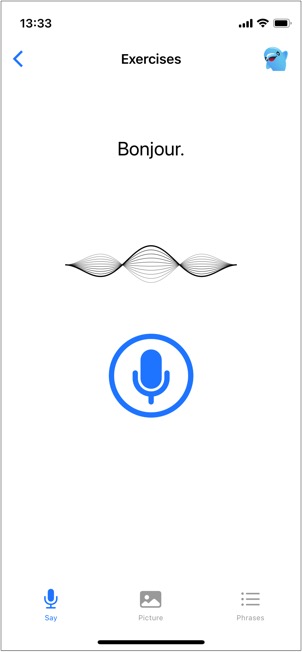
The first and perhaps one of the most important ways an app can help you learn a new language is pronunciation. It’s one thing to read and write in a foreign tongue, but speaking is a whole different animal. After all, if other people can’t understand you when you speak, have you really mastered the language?
Speaking tends to be the most difficult part of language learning as it’s more spontaneous. As a result, it can be nerve-wracking, especially when you’re first starting out. But in order to communicate in a new language, you need to be able to pronounce the words correctly. You can practice all day long and still not be able to gauge your own pronunciation. That’s where the app, Lingidy comes in.
Not only can you listen to correct pronunciations of words you’re learning, but you can also have your pronunciation scored by the application. This is important because you may think you sound like a native speaker. But in reality, maybe you’re not speaking with a good accent or you’re putting the stress in the wrong place.
Within the app, you can listen to the phrase, then repeat what you hear after tapping the microphone to start your recording. When you’re done speaking, tap the microphone again to stop. The app will show you a green checkmark for correct pronunciation, or a red x for incorrect pronunciation. You can practice each phrase as many times as necessary, so take your time turning that red x into a green check!
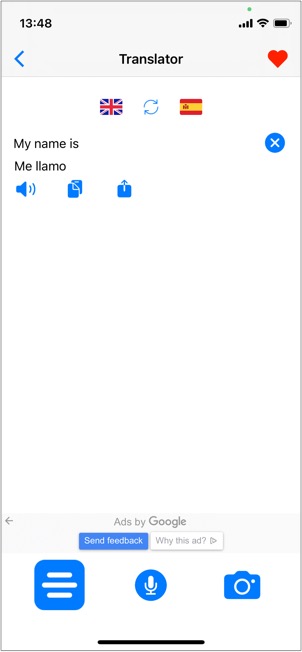
Language apps can be super useful when you’re traveling. If you’re not fluent in the local language of your destination, communication can be an issue if the locals don’t speak your English.
To get past this language barrier when you’re traveling to a Spanish-speaking country, use the Spanish Translator + app.
This app allows you to type, speak, or even take a photo of a phrase and have it translated into English within seconds. Don’t understand what a sign says? Take a photo or type the words into the app. Can’t communicate with the receptionist at your accommodation? Speak into the app and have your words translated instantaneously.
You can also change the direction of the translation, so whether you need English to Spanish or Spanish to English, this app has got you covered.
Once your translation has been generated, you can also choose to play it out loud, copy it, or share it via messaging apps. As a result, Spanish Translator + can eliminate a lot of confusion and make your life easier when traveling abroad.
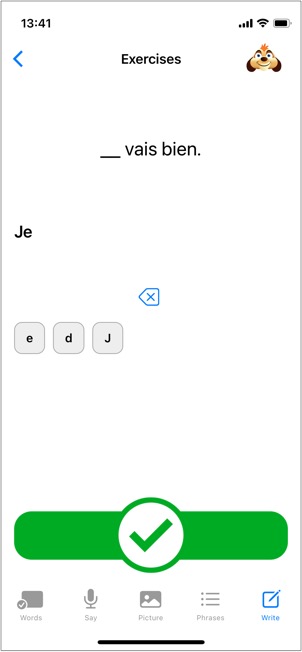
Another important feature of learning a language is spelling the words correctly. This is especially helpful if you’ll be taking a language test or communicating for work via email or messaging boards.
Spelling mistakes can look unprofessional and can even change what you’re trying to say, so it’s best not to make them!
So how can an app help you learn to spell? The app Learn French + has Write exercises. In these exercises, you can listen to a phrase and then fill in the blank by typing what you heard. It’s basically a transcription exercise, which is a great way to practice writing, listening, and spelling.
When you’re done writing the phrase, click the “check” button to be scored. You will see a green check if you’ve spelled it correctly, or a red x if not. And the best part is that you can always go back and keep practicing your mistakes!
If you answer enough exercises correct, you'll even see a dancing meerkat come out to congratulate you.
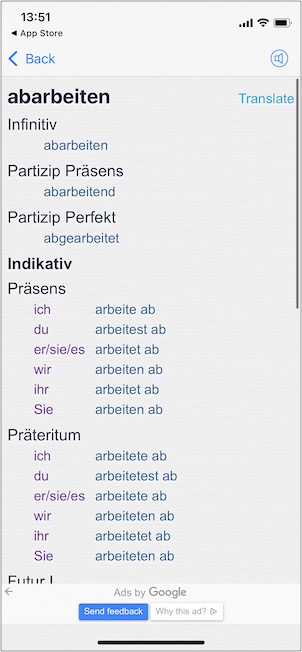
One of the hardest parts of learning a new language for most people is memorizing verb conjugations.
Let’s be real: they’re a lot to remember and it’s easy to get them mixed up.
That’s where the app, German Dictionary + comes in. If you’re not sure about the conjugation of a specific verb, all you have to do is find it in the app. You will then be able to see all possible conjugations.
Not only will it give you present tense conjugations, but you’ll also see the conjugations for different tenses including past, future, and more.
The list of verbs in the app is organized in alphabetical order, so you can scroll through to find what you’re looking for. Or, if you know exactly what you need, type or even speak the verb into the search bar to find it faster.
Once you’ve found your list of conjugations, you can translate any of the words or tap them to listen to the correct pronunciation.
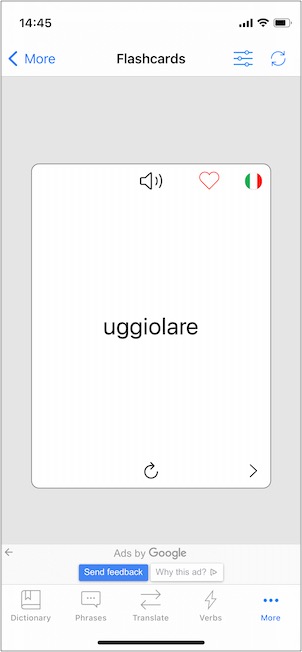
One of the most helpful strategies you can use to learn a new language is repetition. The more you repeat something, the better you’ll remember it.
Seems like a no-brainer, but it’s surprising how often people think they’ve mastered something so they quickly move on to the next thing. But then, they promptly forget everything they’ve already learned because they’re not using repetition to stay fresh.
With the Italian Translator + app, you can use flashcards in your free time to practice vocabulary for common everyday situations. Flashcards is just one of many features including a text, voice and photo transaltor. And if you add a word to favorites using any of these features, you can limit Flashcards to displaying only favorites so you can create your own personalized study lists.
Once you’re using flashcards, test yourself, speak out loud, and listen to the correct pronunciation. If you notice you’re making mistakes, push the heart button on the flashcard to add it to your list of favorites. Once you’re done practicing the full list, use the filters to practice only your favorites, so you can focus on your trouble spots.
Using this feature correctly and often will help you memorize more vocabulary so you’ll be mastering the language in no time.
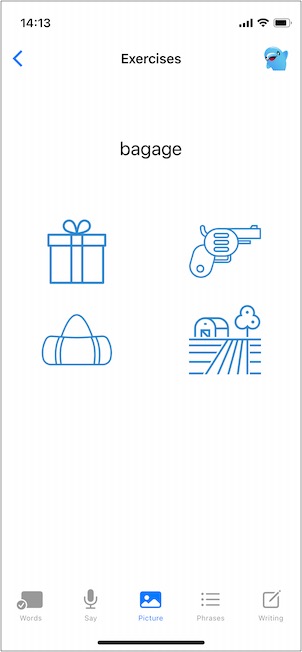
We all have different learning styles, and language apps increasingly strive to accommodate those needs.
With listening and writing exercises available in most language apps, auditory and writing learners have been at an advantage for a long time.
The Lingidy app, however, also has a unique feature to help visual learners, especially with learning vocabulary. Instead of just using flashcards with translations, Lingidy uses Picture exercises to associate vocabulary with a visual cue.
This basically eliminates the middleman, bypassing the English translation in your head, thereby speeding up the process of learning the vocab.
Within the Picture exercises, you will be given a word, which you can either simply read or tap to hear it pronounced. You will also be given multiple illustrations so you can choose the correct photo.
Click the “check” button to see if you’re right and keep practicing as often as you’d like!
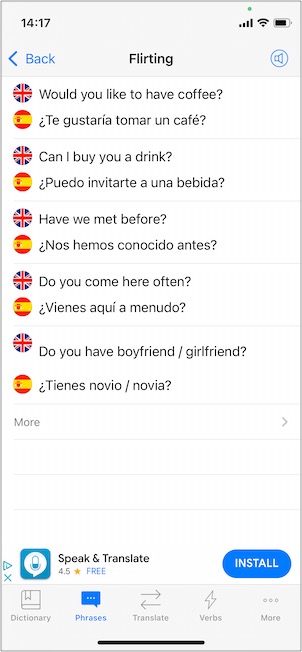
Language courses often focus on teaching students the official or formal way to speak a language. This is great, but a main complaint of students is that they’re still unfamiliar with casual everyday phrases and local slang.
This isn’t a problem when you use the Spanish Translator + app. With this app, you can browse through the categories in the Phrases feature to learn how the locals would say certain things. The app has categories for everything from flirting with someone at a bar to making friends at a hostel.
Once you’ve chosen your category, you’ll see a handful of common phrases related to it. Tap the phrase to play it out loud. You can also hit the speaker icon to change the voice settings.
There are options to hear Spanish phrases in an accent from either Spain or Mexico and you can change the speed, as well.
This feature is also useful since there are different dialects in different places. Since so many countries speak Spanish, the language has its own slang in each place.
Visit the Vidalingua blog to see some examples of Spanish slang. The Spanish Translator + app gives you all of this slang and more, allowing you to speak like a local no matter which country you’re visiting.
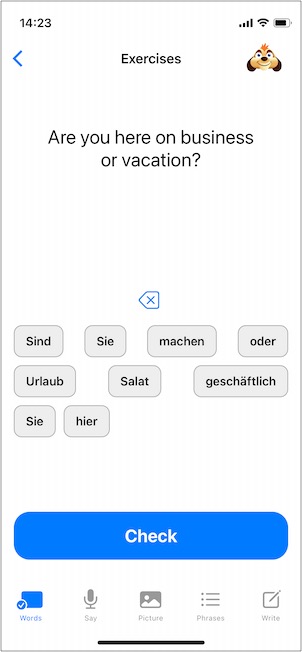
Learning a new language can be especially challenging when that language’s grammar and sentence structure is different from your own.
Figuring out a new word order can be downright confusing. It can even change the meaning of what you’re trying to say if you don’t get it right.
In the Learn German + app, you’ll find Words exercises where your task is to arrange the given words into a complete phrase.
Choose a lesson from the main page and get started. You will be given an English phrase along with a choice of German words underneath. Your job is to choose the German words in the correct order to achieve the same meaning as the English phrase.
When you’re done constructing your sentence in German, push the “check” button to see if you’ve done it correctly. You will see a green check if your translation is right, and red x if not. And you can keep practicing these phrases as often as you’d like.
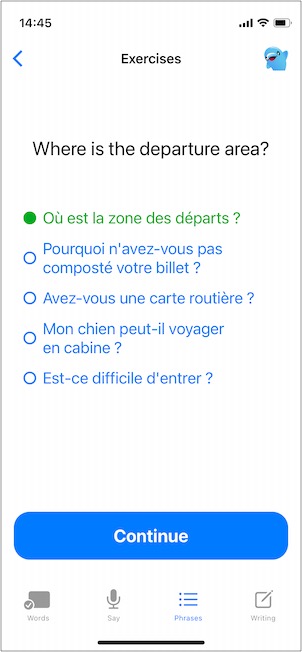
A big part of speaking a new language is understanding when that language is spoken to you. Listening is a huge part of communication as it affects your ability to follow directions and respond to people in kind.
To help hone this important skill, the Lingidy app provides Phrase exercises. These allow you to choose correct translations from a list of possible phrases and listen to spoken phrases.
When you choose the Phrases option, you’ll be given an English phrase along with a few different translations in the language you’re trying to learn. Your task is to choose the best translation of the phrase you were given.
It’s basically a multiple-choice exercise that will help you memorize the most direct translations of important phrases.
You can also tap on the phrase at the top to hear it pronounced. This is a helpful way to master recognition so you'll be ready when they are spoken to you in everyday life.
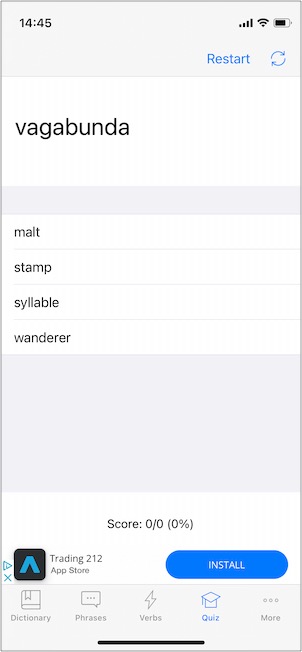
Of course, any language learner needs to be able to track their progress in order to successfully improve.
This is especially true if mobile apps are your main language-learning strategy. And the best way to track your progress is to regularly test yourself!
With the Portuguese Dictionary + app, you can take quizzes to see how well you’re doing and uncover your blind spots. These quizzes allow you to test your knowledge of vocabulary and your understanding of basic phrases.
With these quizzes, you can choose whether you want to practice translating from English to Portuguese or from Portuguese to English.
You will be given a word in one language and you will need to choose the correct translation from four choices.
At the bottom of the screen, you can see your score as you answer each question. You can return to the quizzes and keep practicing at any time.
There you have it: the top 10 ways an app can help you learn a language. Of course, there are many more, but these are the main advantages of using a mobile app to support your language learning. Whether you need a translator for a trip abroad or you’re supplementing your school course, language apps provide a great way to practice. They can even speed up your learning when used correctly and often. So, download one (or several) and get started.
Good luck with your language adventures!

Brittany Muldoon
Blogger @ Vidalingua
More articles you might like...
Some endeavors provide opportunities to expand our horizons. Learning Spanish is one of them and there are some great apps to help.
When abroad, it can be reassuring to know the main French medical vocabulary, just in case. Read this article and you will!
Whether it's to pass a test or to make friends on vacation, the best French learning apps can be game changers. Allons-y mon ami!
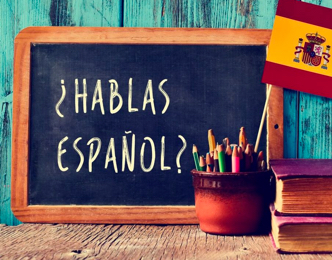
Content of lessons, the length of the course, and the price can be important variables in deciding on an Online Spanish Course.
You might know what 'Sheisse' means in German, but do you know how to say you are a dipshit? You will, once you've read this article.

You might know how to say 'I love you' in French, but do you know the meaning of 'un baiser' or 'un coup de foudre'?
Have you written an article that we should feature in the section above? Email info@vidalingua.com with a link to your article and an explanation of why it would interest our readers.